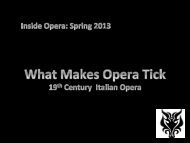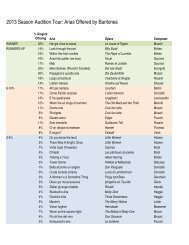Session 1 presentation - Wolf Trap Opera
Session 1 presentation - Wolf Trap Opera
Session 1 presentation - Wolf Trap Opera
You also want an ePaper? Increase the reach of your titles
YUMPU automatically turns print PDFs into web optimized ePapers that Google loves.
Overview<br />
11. Th The Ptht Path to BlC Bel Canto t<br />
The Journey to Reims<br />
2. Mid‐Century Romanticism<br />
La traviata<br />
3. Toward the End of an Era<br />
Falstaff
SESSION 1 – ThePathtoBel The Path to Bel Canto<br />
A Quick Look: <strong>Opera</strong> history before the 19th p y centuryy<br />
Early Baroque<br />
High Baroque<br />
Reform/Classical<br />
Rossini & the Bel Canto Style<br />
Fach<br />
Coloratura soprano<br />
Rossini tenor<br />
Basso cantante / basso buffo<br />
Producing Bel Canto <strong>Opera</strong>s
Florentine Camerata (1570’s (1570’s‐80’s) 80’s)<br />
Vincenzo Galilei (mathematician, musician)<br />
Count Giovanni de’ Bardi (host)<br />
Giulio Caccini (musician)<br />
Pietro Strozzi (military leader)<br />
Ottavio Rinuccini (poet)<br />
Girolamo Mei (historian)<br />
Theory precedes practice.<br />
Words must be understood; polyphony obscures text.<br />
Music should reflect cadence of words rather than dance.
The Birth of <strong>Opera</strong>: 400 Years Ago<br />
Jacopo p Peri & Ottavio Rinuccini<br />
Dafne (~1594)<br />
Jacopo Peri & Ottavio Rinuccini<br />
Giulio Caccini & Ottavio Rinuccini<br />
Euridice (1600)
Discussing Style: Our Vocabulary<br />
Melody the “tune”<br />
Harmony chords, combinations of notes<br />
Rhythm arrangement of sound in time<br />
Texture colors of sound; orchestration<br />
Amplitude loudness, volume<br />
Text words, lyrics<br />
Form structure structure, architecture
Early Baroque<br />
Melody in service of text<br />
Harmony spare, slow-moving<br />
Rh Rhythm th ttext-driven t di<br />
Baroque: (Portuguese)<br />
“mis‐shapen pearl”<br />
Texture strings, keyboards, token winds; fluid<br />
Amplitude relatively small range<br />
Text of supreme importance<br />
device: word painting<br />
Form through-composed<br />
through composed
Monteverdi<br />
(1567‐1643)<br />
HHandel d l<br />
(1685‐1759)
The Pendulum Swings…<br />
FFrom<br />
Simplicity<br />
Cl Clarity it<br />
Balance<br />
Florentine Camerata<br />
1590’s<br />
TTo<br />
Complexity<br />
PPassion i<br />
Vocal Fireworks<br />
High Baroque<br />
~1650‐1750
Early Baroque<br />
(Monteverdi)<br />
High Baroque<br />
(Handel)<br />
in service of text Melody coloratura, fioratura,<br />
melismas, ornaments<br />
spare, slow-moving Harmony<br />
rhythm of speech<br />
strings, keyboards<br />
token winds<br />
of supreme importance<br />
some counterpoint<br />
Rhythm increasingly complex<br />
Texture<br />
relatively small range Amplitude<br />
mythology & history<br />
Text<br />
Subject<br />
more winds:<br />
flute, oboe, trumpet<br />
terraced dynamics<br />
secondary in importance<br />
mythology & history<br />
through-composed Form rigid “number” operas<br />
Da capo aria: ABA form
Baroque <strong>Opera</strong> Seria:<br />
A Rigid Recipe<br />
St Strict i t singer i hierarchy hi h ( (prima i ddonna… assoluta…e l t sola!) l !)<br />
Each main performer must have one aria in each act<br />
Lesser artists: Aria di sorbetto<br />
No performer may have two arias in succession<br />
No aria may be followed by another of the same type<br />
Prima donnas traveled with an Aria di baule (luggage)<br />
Happy ppy ending g required: q<br />
Deus ex machina
The Pendulum Swings…<br />
From To<br />
Simplicity<br />
Complexity<br />
Clarity<br />
Passion<br />
Balance Vocal Fireworks<br />
Florentine Camerata<br />
1590’s<br />
Reform/Classicism /<br />
~1750‐1800<br />
High g Baroque q<br />
~1650‐1750<br />
Organic g structure ( (form ≠ formula) )<br />
Fluid range of emotion<br />
Focus on human drama<br />
Balance between singing singing, text text, orchestra
Mozart<br />
(1756‐1791)
High Baroque Classical<br />
coloratura, l t fi fioratura, t<br />
melismas, ornaments<br />
Mld Melody stripped ti d of f excesses<br />
some counterpoint Harmony<br />
clear foundation<br />
increasingly complex<br />
more winds:<br />
flute, oboe, trumpet<br />
Rhythm<br />
more aligned vertically<br />
Texture clarinet clarinet, horns (dbl winds)<br />
balance melody, text, orch<br />
terraced dynamics Amplitude growth in orchestration<br />
secondary in importance<br />
mythology & history<br />
rigid “number” number operas<br />
Da capo aria: ABA form<br />
Text<br />
Subject<br />
Form<br />
organic, serving the drama<br />
restored to importance<br />
“regular people”<br />
overture as introduction<br />
many more ensembles
Bel Canto* Canto =Beautiful Beautiful Singing<br />
ROSSINI<br />
BELLINI<br />
DONIZETTI<br />
1792‐1868 1792 1868 1801‐1835 1801 1835 1797‐1848 1797 1848<br />
“Bellini is the red wine,<br />
Donizetti is the white wine, ,<br />
and Rossini is the champagne!”<br />
(Edita Gruberova)<br />
(*Term not used until about 1880; reaction to Wagner?)
Gioacchino G oacc o Rossini oss (1792‐1868) ( 9 868)<br />
Dominated opera in first half of 19th century<br />
Wrote 40 operas in just under two decades<br />
Retired from opera at 37<br />
Demetrio e Polibio<br />
Il barbiere di Siviglia<br />
La gazzetta<br />
Otello<br />
La cenerentola<br />
La gazza ladra<br />
Armida<br />
Adelaide di Borgogna<br />
Mosè in Egitto<br />
La cambiale di matrimonio Adina<br />
L'equivoco stravagante Ricciardo e Zoraide<br />
L'inganno felice<br />
Ermione<br />
Ciro in Babilonia<br />
Eduardo e Cristina<br />
La scala di seta<br />
La donna del lago<br />
La pietra del paragone Bianca e Falliero<br />
L'occasione fa il ladro Maometto secondo<br />
Il Signor Bruschino Matilde Shabran<br />
TTancredi di<br />
Zl Zelmira i<br />
L'italiana in Algeri Semiramide<br />
Aureliano in Palmira Il viaggio a Reims<br />
Il turco in Italia<br />
Le Siège g de Corinthe<br />
Sigismondo<br />
Moïse et Pharaon<br />
Elisabetta Regina d'Inghilterra Le Comte Ory<br />
Torvaldo e Dorliska Guillaume Tell
D.H. Lawrence<br />
“II love Italian opera<br />
–it’s so reckless.<br />
Damn Wagner, and<br />
his bellowing at Fate<br />
and death… I like<br />
the Italians who run<br />
all on impulse and<br />
don’t care about<br />
their immortal souls<br />
and don’t worry<br />
about the ultimate.”<br />
Hector Berlioz<br />
“Rossini’s Rossini s melodic<br />
cynicism, his contempt<br />
for dramatic expression<br />
and good sense sense, his<br />
endless repetition of a<br />
single form of cadence,<br />
his eternal puerile<br />
crescendo and brutal<br />
bass drum, exasperated<br />
me to such a point that<br />
I was blind to the<br />
brilliant qualities of his<br />
genius, even in his<br />
masterpiece, The<br />
Barber of Seville.”
Classical<br />
stripped of excesses Melody<br />
clear foundation<br />
vertically aligned<br />
Bel Canto<br />
coloratura coloratura, fioratura<br />
proscribed ornamentation<br />
Harmony straightforward straightforward, diatonic<br />
Rhythm<br />
increased use of rubato<br />
clarinet clarinet, horns (dbl winds) Texture secondary to vocal display display,<br />
balance melody, text, orch<br />
except in opera buffa patter!<br />
growth in orchestration Amplitude “Rossini Rossini crescendo”<br />
crescendo<br />
organic, serving the drama<br />
restored to importance<br />
“regular people”<br />
Text more formulaic<br />
Subject undemanding plot lines<br />
overture as introduction Form<br />
many more ensembles<br />
Aria/Tempo di mezzo/Cabaletta
19th 19 -century century <strong>Opera</strong> Building Blocks<br />
Recitative = Dialogue<br />
Secco<br />
Accompagnato<br />
Aria = Monologue<br />
Aria a (Ca (Cavatina) at a) – Tempo e po ddi mezzo e o – Cabaletta Caba etta<br />
Ensembles = Simultaneous Conversations<br />
Monologues, dialogues, internal monologues
<strong>Opera</strong> Buffa:<br />
The Lighter Side of Bel Canto<br />
Developed from 18 th century intermezzi<br />
Derived from commedia dell’arte dell arte theatrical tradition<br />
Components<br />
• Farcical story<br />
• Quick recitatives<br />
• Patter songs g<br />
•Higher proportion of ensembles<br />
• Happy ending
FACH<br />
Categorization system for opera singers<br />
German = “subject”<br />
Caveats Caveats…<br />
Some singers defy categorization.<br />
SSome roles l can bbe sung bby voices i iin<br />
more<br />
than one category (Zwischenfach).<br />
Fach is affected by size of venue venue, taste of<br />
impresario, composition of cast.<br />
Dangerous when taken to extreme!
FACH: Determining g Factors<br />
The Highs and the Lows<br />
Range singable notes<br />
Tessitura common range<br />
Registration strongest area<br />
PPassaggio i register i t ttransition iti (“break”) (“b k”)<br />
Loudness and Projection<br />
Fluidity<br />
Timbre color<br />
Weight loudness, thickness<br />
Agility coloratura<br />
Fl Flexibility ibilit variety i t iin ddynamic i and d color<br />
l
TYPICAL VOCAL RANGES
Fach Overview – Soprano p<br />
Until the late 18th century, all female singers were sopranos.)<br />
Soubrette (French soubrette = shrewd)<br />
Bell-like Bell like silvery quality; “ina/etta” ina/etta maids, servants<br />
Susanna, Despina, Zerlina, Adina, Norina, Marzelline, Adele, Nannetta, Sophie<br />
Coloratura (Koloratur: add to an idea using main thought as point of departure)<br />
Great agility, agility decorative (Subtypes: lyric coloratura coloratura, dramatic coloratura)<br />
Lucia, Queen, Gilda, Zerbinetta, Fiordiligi, Konstanze, Manon, Juliette<br />
Lyric (“of a lyre”)<br />
Communicate beauty, romance , pathos (JB Steane: “the world’s girlfriend”)<br />
Mimi, Violetta , Marguerite, Micaëla, Liù, Countess, Marschallin, Lauretta<br />
Spinto (spingere: to push) / Lyric Dramatic<br />
Tonal beauty of the lyric and power of the dramatic<br />
Butterfly, Tosca, Aida, Leonoras, Lady Macbeth, Sieglinde, Ariadne<br />
Dramatic (“horn-and-helmet”)<br />
Dramatic ( horn and helmet )<br />
Cut thru large orchestra; warm and metallic; powerful; flexibility compromised<br />
Salome, Elektra, Brünnhilde, Isolde, Marie,Turandot
Rossini Soprano: Coloratura<br />
Koloratur (German): adding to an idea using the main<br />
thought as point of departure<br />
Characteristics:<br />
Great agility<br />
Decorative potential<br />
Subtypes<br />
Lyric coloratura<br />
Dramatic coloratura<br />
Examples: Lucia, Queen, Gilda, Zerbinetta, Manon
FACH Overview – Tenor<br />
(From tenere (to hold): the important line in polyphonic music)<br />
Tenore di grazia / Leggiero<br />
Flexible Flexible, tessitura high (Ottavio (Ottavio, Nemorino Nemorino, Des Grieux)<br />
Coloratura<br />
Agility, extremely high range; bel canto specialist (Almaviva, Ernesto, Arturo)<br />
Comic (Spieltenor)<br />
Character type (Beppe, Goro, Pedrillo, Tanzmeister, Monostatos)<br />
Lyric<br />
Beauty of tone; “squillo” to project over large orchestra (Lensky, Faust, Rodolfo)<br />
(Before1830’s, no full voice above passaggio)<br />
Lirico-Spinto to Tenore Robusto<br />
Heroic; stamina and volume (Cavaradossi, José, Otello, Radames, Calaf)<br />
Heldentenor / Tenore di forza<br />
Heldentenor / Tenore di forza<br />
Baritonal hue; powerful midvoice (Florestan, Lohengrin, Siegmund, Tannhäuser)
RRossini i i TTenor: CColoratura l t<br />
Characteristics:<br />
Great agility<br />
Decorative potential<br />
VVery hi high h range<br />
Examples: Almaviva Almaviva, Ernesto Ernesto, Arturo
Fach Overview – Bass<br />
Distinctions between lower voices began in second half of the 19 th century<br />
Bass-baritone<br />
Baritone w/bottom extension, extension bass w/top extension<br />
Don Giovanni, Figaro<br />
Basso cantante<br />
Lyrical (“singing”) ( singing ) bass voice, typically not particularly large<br />
Handel low roles<br />
Basso buffo (Spielbass)<br />
Comic bass<br />
Osmin, Leporello, Basilio, Bartolo, Ochs<br />
Lyric bass / Basso cantabile<br />
More heft than basso cantante, slightly g y lower tessitura<br />
Dapertutto, Escamillo, Sarastro, Ferrando<br />
Dramatic bass / Basso profondo<br />
King g Philip, p Wagner g<br />
roles
RRossini i i BBasses<br />
Basso cantante<br />
Basso cantante<br />
Lyrical (“singing”) bass voice, typically not<br />
particularly large
RRossini i i BBasses<br />
Basso buffo (Spielbass)<br />
Basso buffo (Spielbass)<br />
Osmin, Leporello, Basilio, Bartolo, Ochs
<strong>Session</strong> 1: Viaggio Excerpts<br />
Venue: Vienna 1998<br />
Conductor: Riccardo Muti<br />
Production by Luca Ronconi<br />
Cast:<br />
Corinna Cecilia Gasdia<br />
La Marchesa Melibea Lucia Valentini‐Terrani<br />
La Contessa di Folleville Lella Cuberli<br />
Madama Cortese Montserrat Caballe<br />
Il Cavaliere Belfiore Frank Lopardo<br />
Il Conte di Libenskof Chris Merritt<br />
Lord Sidney Ferruccio Furlanetto<br />
DDon Profondo P f d RRuggero Ri Raimondi di<br />
Il Barone di Trombonok Enzo Dara<br />
Don Alvaro Carlos Chausson<br />
Don Prudenzio Giorgio Surjan





